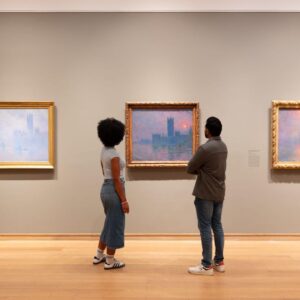Wakehurst, Kew’s wild botanic garden in Sussex, will soon be home to one of the UK’s largest outdoor art installations. Commissioned to wrap the Elizabethan Mansion, currently undergoing an extensive roof restoration, Planet Wakehurst is a bespoke photo montage from Australian-born artist Catherine Nelson. Using photography of plants from across the 535-acre site captured in summer 2022, the dazzling installation is a celebration of Wakehurst’s biodiversity, from the colourful blooms of the abundant Water Gardens to the towering Giant Redwoods of California in Horsebridge Wood.

Measuring over 1550m2, Nelson’s UK premiere installation will form the equivalent of 25 double-decker buses, wrapping around three sides of the Mansion. Nelson spent hot summer days in 2022 documenting the vast site and, over the course of six months, used the hundreds of photographs captured to create the immense digital collage. Visitors will have the chance to see beautiful species magnified in exceptional
detail, offering new perspectives on the flora which makes Wakehurst so special, and sparking curiosity into science research conducted across this unique living laboratory.


The result is something real yet unreal. I use elements that are real, that is photographs, but put them together using my imagination. I thought a lot about Monet, looking at his summer garden paintings, and I wanted the South elevation to be able to compete with sunny Wakehurst days, so I kept the palette bright and colourful. The West Elevation instead has a dusk feel whilst for the East elevation I looked at Golden Age landscape paintings with their dramatic skies, looking to create a different mood. My work is about nature with a keen awareness of the need for its conservation. I hope people leave Planet Wakehurst with a life affirming feeling. We have a beautiful planet, and we need to take care of it.
Artist Catherine Nelson
Nelson is a visual artist who uses the camera and digital medium as a paintbrush. After studying painting at art school, Nelson moved into film visual effects, working on big budget productions including Moulin Rouge, Harry Potter and 300 where she harnessed her digital skills which she now applies to her photomontage artworks and videos.
The installation will also house a new viewing platform. Raised 33ft above ground level, the lookout point will carve out a new experience for visitors to the Sussex site, affording stunning views across the Mansion lawns and out to the Sussex Downs beyond. This is the first time visitors will be able to take in Wakehurst’s spectacular landscape and the surrounding countryside from this elevation.

Lorraine Lecourtois, Wakehurst’s Head of Public Programmes says:
Our Mansion roof work forms the biggest restoration project of the last century. We knew the vast scale of the site with its layers of scaffolding poles and boards could form a magnificent canvas, but we had no idea just how spectacular this opportunity was until we started working with Catherine Nelson. Her vision for Planet Wakehurst will transform a building site into an artwork unlike anything you’ll see around the country. Her connection with our collections and our critical science research is palpable in her work. Her consideration for our important plant collections and her passion for Kew’s mission to halt biodiversity loss has resulted in a truly striking work. We can’t wait to welcome visitors old and new to experience Planet Wakehurst.
Wakehurst, Ardingly, Haywards Heath, Sussex, RH17 6TN kew.org/wakehurst
About the Mansion roof restoration project

The Elizabethan Mansion, built in 1571-1590 and set in the heart of the gardens, requires an extensive roof restoration to preserve the Grade I listed building, originally bequeathed to the National Trust in 1963 and entrusted to Kew in 1965, for future generations. Building work is expected to last over two years. Wakehurst has ensured that the Mansion’s resident bats and swifts are protected for the duration of the
project. With approval from Natural England, the restoration work will be phased to account for breeding and hibernating seasons. Temporary roosts will also be created to ensure minimal disturbance and limit the impact on wildlife. Visitors to Wakehurst will find information panels around the site where they can discover more about the project, the steps taken to protect resident wildlife, and much more. Volunteer explainers and tour guides will also have further detail on the project.






